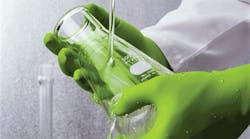'Breaking Bad' Habits (or How to Establish a Chemical Resistant Glove Program)
It warms my heart when Hollywood pays homage to the tireless efforts of us regular working folks, particularly those of us in industrial professions. I recently watched the first episode of "Breaking Bad," the highly acclaimed television show about high school chemistry teacher Walter White, who turns into a drug kingpin to secure a better financial future for his family after he is diagnosed with terminal lung cancer.
With his background in science and chemistry, there was no way Walter was going to start "cooking" meth without donning the proper personal protective equipment (PPE).
See Also: Personal Protective Equipment (PPE) Safety Standards
Obviously that is a far cry from what we do day-in, day-out, but it does show us there are more and more realizations of the hazards of the workplace – even if that workplace is a meth lab in the back of an RV.
Even OSHA, in its recent technical amendment to the OSHA Laboratory Standard, lauded the changes in culture in safety laboratories. As part of its amendment, OSHA states, "With the promulgation of the Occupational Safety and Health Administration Laboratory Standard, a culture of safety consciousness, accountability, organization and education has developed in industrial, governmental and academic laboratories. Safety and training programs have been implemented to promote the safe handling of chemicals from ordering to disposal, and to train laboratory personnel in safe practices." This culture of safety is what we in the personal protection industry have been preaching for years.
corrosive
A Part of Everyday Life
At least 400 million tons of chemicals are produced each year worldwide and at least 1,200 new chemicals are developed each year in North America alone. While OSHA gave some kudos for the culture of safety in our workplaces, we cannot let our guard down. Skin exposure to chemicals remains a significant problem. In 2010, 34,400 recordable skin diseases were reported by the Bureau of Labor Statistics (BLS) at a rate of 3.4 injuries per 10,000 employees, compared to 19,300 respiratory illnesses with a rate of 1.9 illnesses per 10,000 employees.
Nearly all workers today are exposed to some sort of chemical hazard since chemicals are used in every type of industry. Chemicals can enter the body any number of ways inhalation, ingestion, injection and absorption. Perhaps one of the most insidious routes chemicals can enter the body is through absorption through the skin, specifically the hand. Many studies indicate that absorption of chemicals through the skin can occur without being noticed by the worker.
Since most chemicals readily can be absorbed through the skin, it is important to learn as much as possible about the chemicals you work with. Skin contact with chemicals can result in irritation, allergic response, chemical burns and allergic contact dermatitis.
Selecting the Best Hand Protection
Impervious gloves made of butyl, natural rubber latex, neoprene, nitrile, polymer, PVC and Viton are designed for handling chemicals and hazardous substances that may damage the skin, but because different materials resist different chemicals, it is important to select the right glove for chemical to which employees will be exposed.
With all these chemicals in the workplace and so many options for hand protection, determining the right glove for the job can seem overwhelming. Like all safety programs, developing a chemical-resistant glove protection program follows a three-step process: recognize, evaluate and control.
Step 1: Recognize – It is important to recognize the prevalence of chemicals in the workplace and identify what chemicals are present and where in the operations the chemicals are used. Occupational skin diseases are the second most-common type of occupation disease. OSHA even has provided more specific standards for workers exposed to hazardous and toxic substances in the shipyard, marine terminal, construction and dry cleaning industries. Step 2: Evaluate – Once you know what chemicals are in your environment, you have to evaluate the chemical form, routes of exposure, level of exposure and number of employees exposed. Step 3: Control – This evaluation will guide the determination of whether you can reduce exposure levels through the use of engineering and/or administrative controls. PPE is considered the last line of defense to create a barrier against workplace hazards. Proper glove selection is a major means of protection. Factors that affect glove selection are:➠ Type of chemical(s) to be handled (or used)
➠ Frequency and duration of chemical contact (often to rarely)
➠ Nature of contact (total immersion, splash, mist, contaminated surfaces)
➠ Concentration of the chemical
➠ Temperature of the chemical
➠ Abrasion, puncture, tear resistance requirements of the job or task
➠ Length to be protected (hand only, forearm, arm)
➠ Dexterity requirements of the job or task
➠ Grip requirements (dry grip, wet grip, oily)
➠ Glove features (e.g. cuff edge, lining, color to show contamination)
➠ Thermal protection
➠ Size and comfort requirements
➠ Price
Like all good safety programs, the organization must assess and protect employees from hazards and provide training and education. Employees too must take an active role. They should inform themselves of the hazards and what precautions to take to comply with workplace rules and use appropriate PPE properly. If there are bad PPE habits out there, now is the time to break them.
David Shutt coordinates Showa Best Glove’s new product development in general purpose, disposable and chemical-resistant glove lines among research and development, field sales and marketing teams, as well as distributor and end-user customers. A 20-plus-year veteran of the glove industry, he holds a degree in business administration from Malone. For more info about glove selection, applications and chemicals, visit http://www.chemrest.com.
